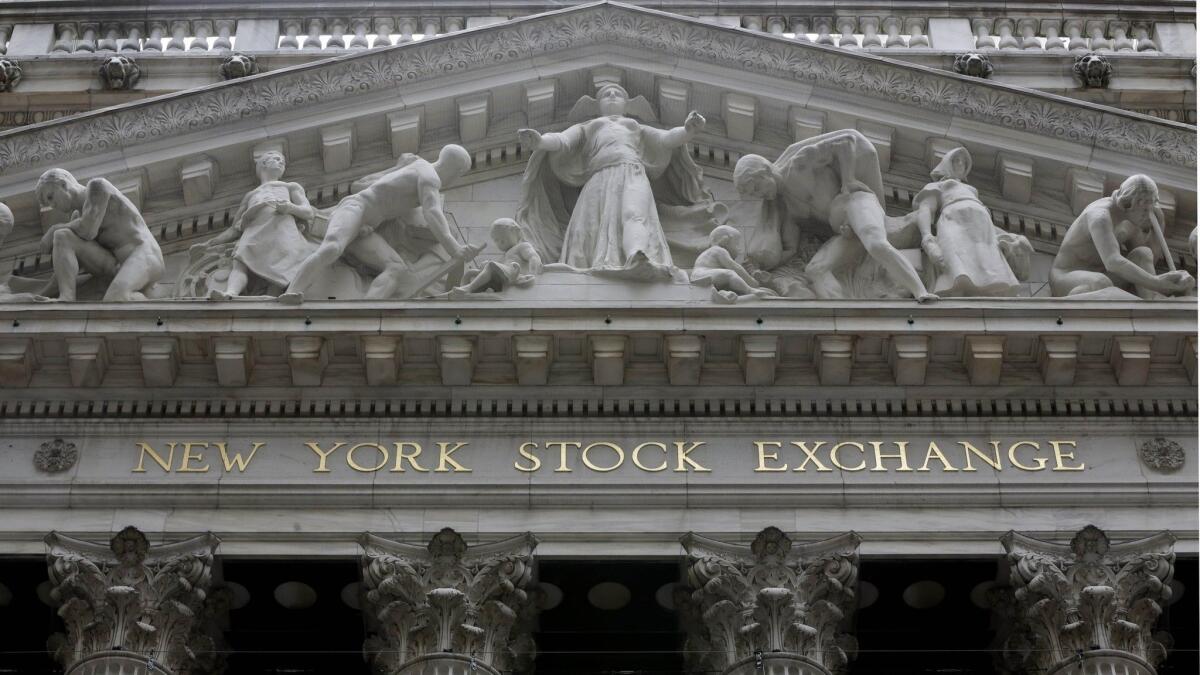Stocks edge up to new record highs

- Share via
U.S. stock indexes edged up further into record territory Monday following more signs that the economy is growing in the not-too-hot, not-too-cold way that investors love.
The Standard & Poor’s 500 index ticked up 3.15 points, or 0.1%, to 2,943.03. Big gains for banks led the way on hopes for bigger profits from making loans, but losses for high-dividend stocks held indexes in check.
The Dow Jones industrial average edged up 11.06, or less than 0.1%, to 26,554.39. The Nasdaq composite rose 15.46, or 0.2%, to 8,161.85. Both the S&P 500 and the Nasdaq closed at record highs.
After rocketing higher in the first few months of the year, the S&P 500 has seen its momentum moderate in recent weeks. Trading has remained relatively quiet, as reports on the economy and corporate profits come in better than analysts expected and give investors further confidence that the economy can avoid a recession.
“I think it’s healthy to see these sideways or even slightly down days,” said Nate Thooft, senior portfolio manager at Manulife Asset Management. “This is just digesting the big move we had earlier in the year.”
The S&P 500 is up 17.4% so far in 2019, and it has more than erased its nearly 20% drop from late last year when worries were high that the Federal Reserve could cause a recession by raising interest rates too quickly.
“We’re kind of in complacency land, Goldilocks land,” Thooft said. “That in itself is a little bit alarming, but I don’t see what changes it either.”
Helping to spur Monday’s gains was a report from the Commerce Department that showed a U.S. economy that’s growing, but not at too hot a pace. Consumer spending jumped 0.9% in March, the biggest gain in nearly a decade. But the same report also showed that the Federal Reserve’s preferred measure of price changes remains well below its target.
Low inflation gives the central bank more leeway to hold off on raising interest rates, and it was the Fed’s pledge this year to be patient on rates that sent stocks surging. The Federal Reserve will meet again on interest rates this week, and most investors expect no changes.
More relief is also coming from ongoing negotiations between the United States and China as they try to end a costly trade war. Both sides have said they are making progress and are continuing talks this week.
Analysts say companies across the S&P 500 index may end up reporting slightly higher profits for the first quarter than the same quarter last year. Just a few weeks ago, Wall Street was predicting the first drop in earnings in nearly three years.
Nearly a third of the companies in the S&P 500 are scheduled to report their results for the first quarter this week, including CVS Health, General Motors and McDonald’s.
Treasury yields rose with the encouraging data on consumer spending, and the yield on the 10-year Treasury climbed to 2.52% from 2.50%.
Higher interest rates can mean bigger profits for banks, and financial stocks in the S&P 500 jumped 0.9%. Shares of JPMorgan Chase and Bank of America both rose 1.4%.
On the losing side were utility stocks and real estate investment trusts, which are big dividend payers. When bonds pay more in interest, it can dull the appeal of dividend-paying stocks.
Real estate stocks in the S&P 500 dropped 1.1%, and utilities sank 0.6%.
Benchmark U.S. crude rose 20 cents to settle at $63.50 a barrel. Brent crude, the international standard, fell 11 cents to $72.04 a barrel.
Natural gas rose a penny to $2.59 per 1,000 cubic feet. Heating oil was virtually flat at $2.05 a gallon. Wholesale gasoline fell 2 cents to $2.08 a gallon.
Gold fell $7.30 to $1,281.50 an ounce. Silver fell 16 cents to $14.93 an ounce. Copper was virtually flat at $2.90 a pound.
The dollar rose to 111.71 Japanese yen from 111.61 yen. The euro rose to $1.1183 from $1.1154. The British pound ticked up to $1.2935 from $1.2925.
More to Read
Inside the business of entertainment
The Wide Shot brings you news, analysis and insights on everything from streaming wars to production — and what it all means for the future.
You may occasionally receive promotional content from the Los Angeles Times.










